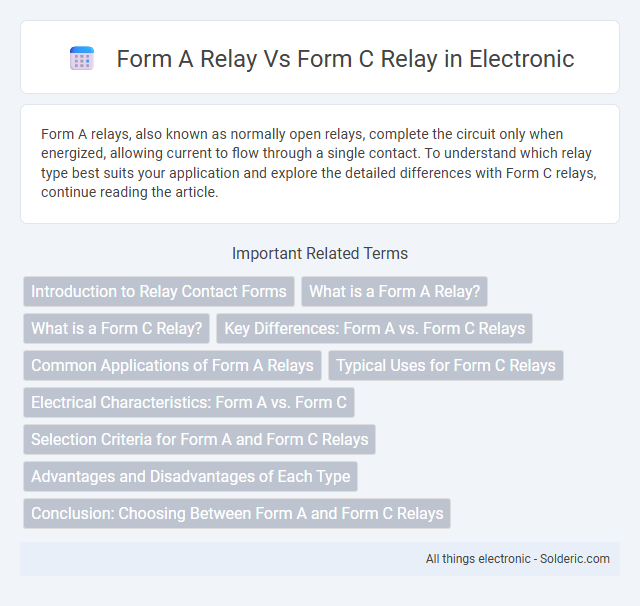Form A relays, also known as normally open relays, complete the circuit only when energized, allowing current to flow through a single contact. To understand which relay type best suits your application and explore the detailed differences with Form C relays, continue reading the article.
Comparison Table
| Feature | Form A Relay | Form C Relay |
|---|---|---|
| Contact Type | Normally Open (NO) | Changeover (NO + NC) |
| Number of Contacts | Single | Double (Common, NO, NC) |
| Switching Function | Connects circuit when energized | Switches between two circuits |
| Use Case | Simple On/Off control | Switching between two signals or lines |
| Common Applications | Lighting control, basic switching | Signal routing, failover systems |
| Wiring Complexity | Simple | Moderate |
| Cost | Lower | Higher |
Introduction to Relay Contact Forms
Form A relays feature a single normally open (NO) contact, allowing current flow only when the relay is energized, making them ideal for simple on-off control circuits. Form C relays include a changeover contact with a common terminal that switches between normally closed (NC) and normally open (NO) states, providing versatile switching capabilities for complex control applications. The distinction in contact configurations between Form A and Form C relays directly impacts their suitability for different electrical switching tasks.
What is a Form A Relay?
A Form A relay, also known as a normally open (NO) relay, features a single set of contacts that remain open when the coil is unenergized and close when energized, allowing current to flow. This type of relay is commonly used in applications where switching a circuit on with an electrical signal is required. Its simple design provides reliable operation for controlling loads such as motors, lights, and other devices.
What is a Form C Relay?
A Form C relay is an electromechanical device featuring a single pole double throw (SPDT) switch that allows one common terminal to connect to either a normally open (NO) or normally closed (NC) contact. This configuration enables the relay to control two circuits, switching between connected and disconnected states, which differs from a Form A relay that has only a normally open contact. Form C relays are widely used in applications requiring versatile switching capabilities such as control panels, automation systems, and signaling circuits.
Key Differences: Form A vs. Form C Relays
Form A relays are single-pole single-throw (SPST) devices that provide normally open contacts, allowing current to flow only when energized. Form C relays feature single-pole double-throw (SPDT) contacts with both normally open and normally closed positions, enabling switching between two circuits. Your choice depends on whether you need simple on/off control with a Form A relay or versatile switching capabilities with a Form C relay.
Common Applications of Form A Relays
Form A relays, also known as single-pole single-throw (SPST) normally open relays, are commonly used in applications requiring simple on/off control, such as lighting circuits, motor starters, and signal switching. Their straightforward design makes them ideal for devices that only need to complete or break a circuit without switching between multiple contacts. Form A relays are favored in HVAC systems, home automation, and automotive electronics due to their reliable single-contact operation and cost-effectiveness.
Typical Uses for Form C Relays
Form C relays are typically used in applications requiring both normally open (NO) and normally closed (NC) contacts, such as control circuits, switch backups, and safety interlocks. Their versatility makes them ideal for switching between two different loads or signals within industrial automation systems and security devices. You can rely on Form C relays for precise control in complex electrical setups where alternate current paths are needed.
Electrical Characteristics: Form A vs. Form C
Form A relays, also known as SPST (Single Pole Single Throw) normally open contacts, provide a simple closing circuit when energized, typically rated for switching voltages up to 250V AC and currents ranging from 5A to 30A. Form C relays feature SPDT (Single Pole Double Throw) contacts, including both normally open and normally closed circuits, enabling control of two circuits simultaneously and supporting comparable voltage and current ratings but with higher versatility for complex switching applications. Electrical characteristics such as contact arrangement, switching capacity, and dielectric strength differ subtly, with Form C relays often requiring more robust insulation and contact separation due to the dual-contact design.
Selection Criteria for Form A and Form C Relays
Selection criteria for Form A and Form C relays center on the type of circuit control required: Form A relays provide a normally open contact configuration ideal for simple on/off switching applications, while Form C relays offer a changeover contact allowing simultaneous switching between two circuits. Consider load type, switching voltage, and current ratings to ensure compatibility with the relay contacts, and assess the application's need for isolation or redundancy. Environmental factors, such as operating temperature and mechanical durability, further influence relay choice for reliable performance.
Advantages and Disadvantages of Each Type
Form A relays offer simple normally open contacts, providing reliability and ease of use in basic switching applications with low cost and straightforward wiring. Form C relays include both normally open and normally closed contacts, allowing versatile control and failsafe operation but involve higher complexity, larger size, and increased cost. Choosing between them depends on your application's need for simplicity versus flexibility and fail-safe features.
Conclusion: Choosing Between Form A and Form C Relays
Form A relays, known as normally open contacts, are ideal for simple switching tasks where energizing the coil closes the circuit. Form C relays feature both normally open and normally closed contacts, providing greater versatility for complex control systems requiring fail-safe operation or switching between two circuits. Selecting between Form A and Form C relays depends on the application's need for either straightforward on/off control or more advanced switching functionality.
Form A relay vs Form C relay Infographic

 solderic.com
solderic.com